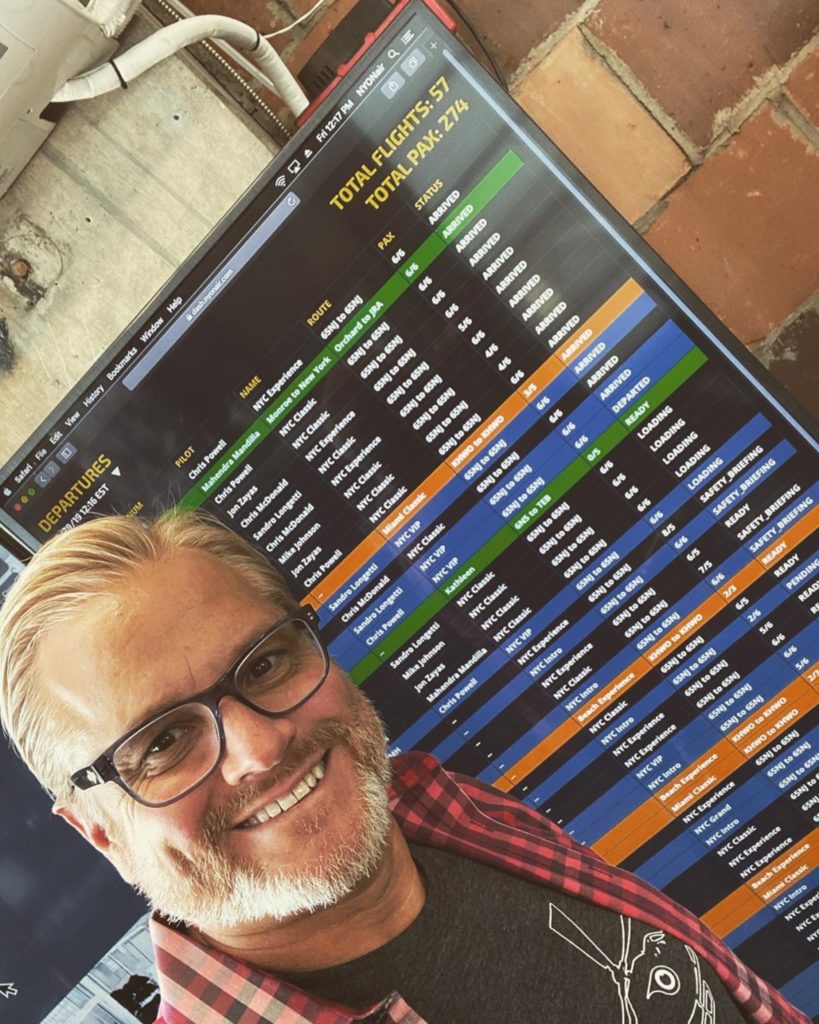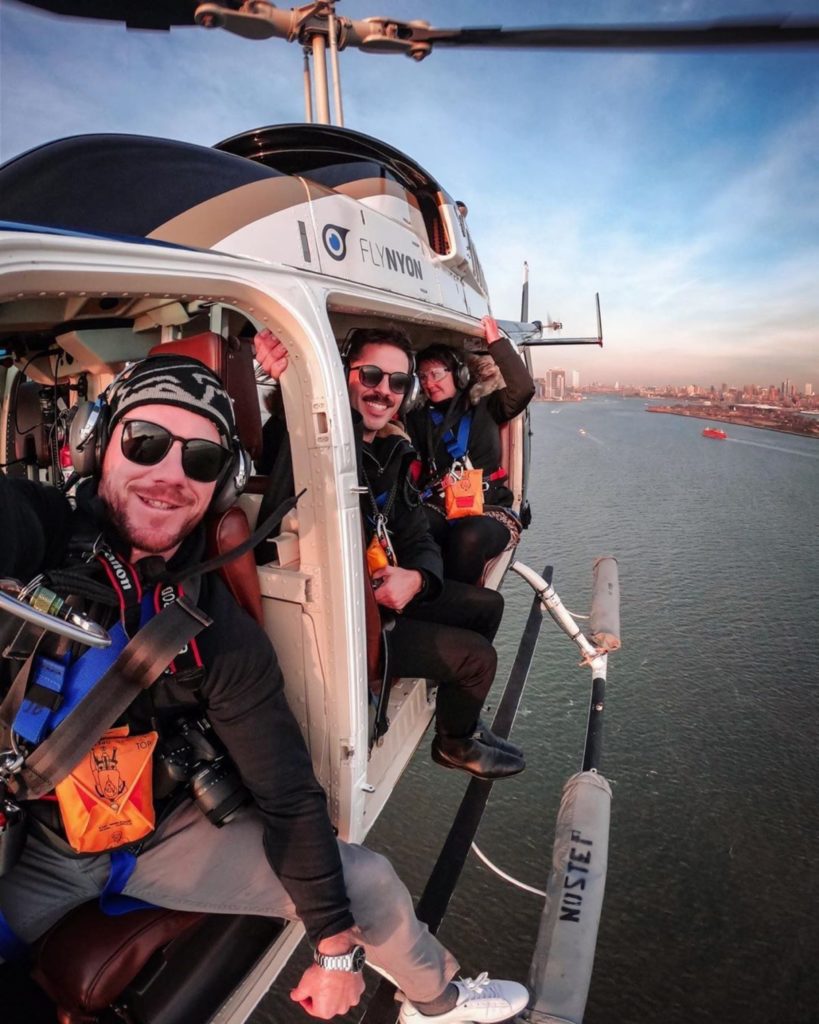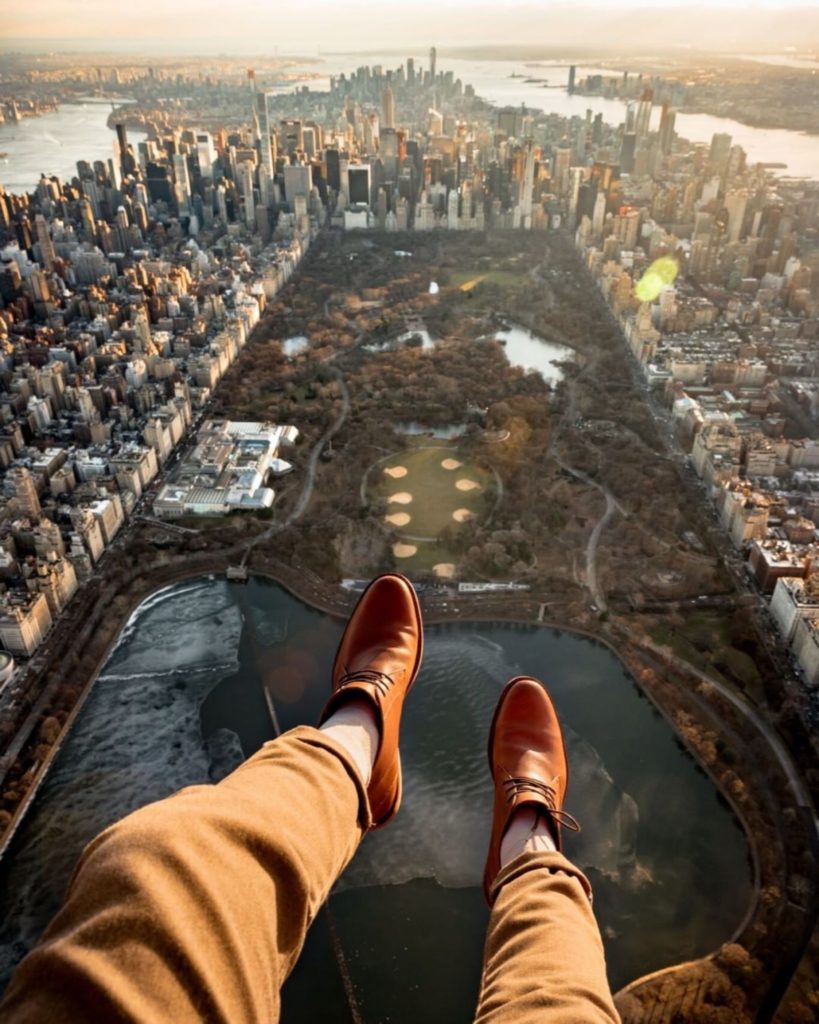
The doors-off helicopter tour company FlyNYON built its business on a regulatory loophole, and the Federal Aviation Administration (FAA) should step in to close it.
That’s according to members of the National Transportation Safety Board (NTSB), who met Tuesday to determine the probable cause of a March 11, 2018, accident involving a Liberty Helicopters Airbus AS350 B2 on a doors-off FlyNYON photo flight. Five passengers who were tightly harnessed to the helicopter drowned when it made a forced landing to New York City’s East River and overturned in the water.
Advertisement
The board found the immediate cause of the accident to be the use of a passenger harness and tether system provided by NYONair (FlyNYON’s parent company). The front seat passenger’s tether caught on and activated the floor-mounted engine fuel shutoff lever as he leaned back to take “shoe selfies” — “which is exactly what [he was] supposed to be doing on that flight [because that] is exactly how FlyNYON marketed it,” pointed out board member Jennifer Homendy.
The activation of the fuel shut-off lever caused the helicopter to lose power in flight, the board confirmed. The pilot successfully entered an autorotative glide and pulled a cyclic-mounted handle to activate the emergency flotation system. However, the floats inflated partially and asymmetrically, causing the helicopter to become fully inverted and submerged within 11 seconds. The passengers’ egress was hindered by the NYONair harness system, which “turned a perfectly good helicopter into a death trap,” according to board chairman Robert Sumwalt.
The board also identified several contributing factors to the accident, including Liberty and NYONair’s “deficient safety management, which did not adequately mitigate foreseeable risks associated with the harness/tether system.” The NTSB’s investigation confirmed that, as previously reported by Vertical, Liberty pilots were aware of and repeatedly voiced concerns about hazards including the passenger harness and tether system. However, Liberty’s upper-level managers, notably director of operations Patrick Day, Sr. — the father of NYONair CEO Patrick Day, Jr. — “were disengaged from day-to-day operations and did not advocate for the pilots’ concerns.”
The NTSB found that Liberty improperly allowed NYONair to influence the operational control of Liberty’s FlyNYON flights, and that Patrick Day, Jr. “chastised the pilots and deprioritized their concerns.” Homendy highlighted several such exchanges, including one in which Day declared that FlyNYON’s motto is “rubbin’ is racing” — a reference to the Days of Thunder adage about playing rough — and said that pilots “just can’t get their snowflake feelings hurt.”
The board also had harsh words for the FAA’s “inadequate oversight” of commercial passenger-carrying operations conducted under Federal Aviation Regulations part 91. At the time of the accident, Liberty and NYONair were conducting their doors-off flights as “aerial photography” flights, exempting them from the stricter regulations that normally apply to air tour operations. Despite concerns raised by other FAA inspectors, the principal operations inspectors for Liberty and NYONair decided they didn’t need to evaluate these doors-off operations.
Consulting with the FAA’s legal department, the NTSB found that the agency intended “aerial photography” to include “only business-like, work-related aerial operations” — such as those conducted by trained professional photographers, not tourists wanting to take cell phone photos of their feet. NTSB investigator David Lawrence noted that FAA inspectors should have conducted the same due diligence: “Had they done that, they would have gotten the same legal interpretation that we received, [which] said this is not aerial photography, it was an air tour.”

The board highlighted how NYONair deliberately exploited the aerial photography loophole, advising its personnel to avoid the words “tour,” “route,” and “sightseeing,” and to instead use the words “custom,” “photo flight,” and “photography.”
“These companies were knowingly exploiting a loophole to avoid stronger regulation and oversight and people died because of it,” Sumwalt emphasized. The NTSB wants the FAA to establish clear definitions for the terms “aerial work” and “aerial photography” that specify only business-like, work-related aerial operations, as originally intended.
The FAA is currently allowing FlyNYON to conduct its tour operations under part 91 and part 136 with a letter of authorization (LOA. Liberty is no longer performing the doors-off flights). While part 136 imposes some additional requirements on the company, those fall far short of the part 135 safety rules that most passenger-carrying operations must comply with.
The NTSB revived a recommendation it initially made to the FAA in 1995 that all air tour operations be conducted under part 135. In 2007, when the FAA instead introduced part 136 — allowing small operators to conduct local tour flights without part 135 regulatory burdens — the NTSB marked its recommendation “closed – unacceptable action.”
“In this particular accident, [Liberty and NYONair] were operating under an egregious interpretation of current regulations — there’s no doubt about that,” said board member Homendy. “However, now NYON is operating under part 91 and 136 and an LOA, which is exactly what the NTSB opposed in [2007] when we closed this recommendation. Unacceptable.”

Sumwalt echoed, “Why is the FAA not requiring that higher level, that higher standard of care? . . . I think we need to take a hard line and say that by George if you’re going to charge people to go up for an air tour, it will be conducted on your part 135.”
New harnesses still cause for concern
In the meantime, the NTSB wants the FAA to immediately prohibit the use of supplemental passenger restraint systems for passenger-carrying doors-off operations until the agency can overhaul its review process for the devices.
In the aftermath of the accident, when it became apparent that FlyNYON’s supplemental harnesses contributed to the fatalities, the FAA temporarily prohibited doors-off operations involving restraints that cannot be released quickly in an emergency. It later began issuing LOAs for use of supplemental harnesses, contingent upon operators demonstrating — via a video uploaded to YouTube — that the devices could be released quickly.
That’s not good enough, said the NTSB, which also wants the FAA to evaluate how the harnesses will be used, the potential for passengers to become entangled during emergency egress, the adequacy of passenger emergency egress briefings, and the potential for the devices to interfere with aircraft controls.
Homendy expressed skepticism that the new style of quick-release harnesses currently being used by FlyNYON — in conjunction with the FAA-approved seatbelts and shoulder harnesses in the Bell 206L LongRangers it now uses for doors-off flights — actually enhance safety.
“FAA looked at a seven-second video, and this helicopter inverted in 11 seconds,” she said. “How is it any safer that you now have a harness that you have to quick release, you have an FAA restraint — a seatbelt — that you have to quick release, and then you have to get over the headset, which we have said can possibly cause entanglement, and then get out, after no testing?”
Sumwalt reiterated, “These types of doors-off flights with dangerous supplemental restraints that could get tangled or caught on something and hamper escape ought to stop before others get hurt.”

The NTSB also made two recommendations to the FAA related to emergency flotation systems. Investigators found that on the accident flight, the pilot did not pull the float activation handle through its full travel and only one of the two gas reservoir assemblies on the DART Aerospace-manufactured system activated. Subsequent tests found that full activation would have required force in excess of 58 pounds — nearly impossible to achieve with one hand given the mounting angle of the handle.
The NTSB wants the FAA to review other rotorcraft emergency flotation systems for deficiencies that may preclude their proper deployment. Plus, the agency should revise its certification guidance for emergency float systems to include human factors objectives, such as “clear, unambiguous, and positive feedback to pilots to indicate that the float system was successfully deployed.”
The board also recommended to Airbus that it modify the floor-mounted fuel shutoff lever in certain AS350 helicopters “to protect it from inadvertent activation due to external influences,” and that the European Union Aviation Safety Agency — the original certifying agency for the model — should mandate the modification on existing helicopters.
The front-seat passenger’s intoxication, previously reported by Vertical, was not extensively discussed by the board, as it determined that the passenger’s positioning was more relevant to the tether tail becoming entangled with the fuel shutoff lever. However, the NTSB did adopt a finding that “when passengers are seated in close proximity to an aircraft’s controls, it is critical that they not be impaired to reduce the likelihood of interference with the pilot’s ability to safely fly the aircraft.”
The board also recommended that Liberty and NYONair train their employees to identify signs of impairment and intoxication in passengers and to deny those passengers boarding when appropriate. And, it recommended that the FAA develop guidance on how to identify intoxicated or impaired passengers and distribute this to operators who carry passengers for hire.
An FAA spokesperson declined to respond to specific questions, telling Vertical only, “We are reviewing the NTSB’s recommendations and will respond as required within 90 days.”
When contacted for comment by Vertical, FlyNYON spokesperson Jason Kaplan, a crisis communications specialist with the outside public relations firm SKDKnickerbocker, also declined to answer specific questions related to the board’s concerns. Instead, he doubled down on FlyNYON’s assertion that the design of the aircraft’s floor-mounted fuel shutoff lever and emergency flotation system were wholly to blame for the crash, seizing on Sumwalt’s observation that had the helicopter not overturned, the harnessed passengers would have likely survived.
Disregarding Sumwalt’s additional characterization of the NYONair harnesses “turning a perfectly good helicopter into a death trap,” Kaplan told Vertical in an email: “As Chairman Sumwalt emphasized during today’s hearing, if the emergency flotation system had operated as designed and certified, any issues with the harness and tether system are immaterial. We support the recommendations of the NTSB to the FAA to evaluate and address these significant safety issues.”


